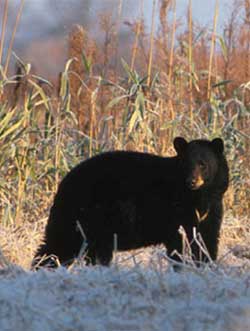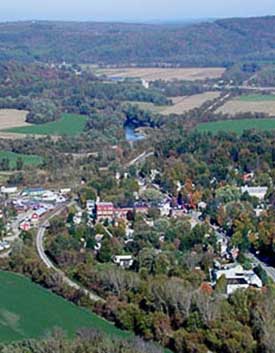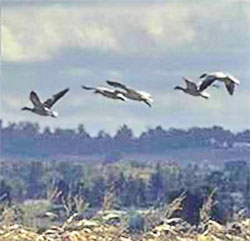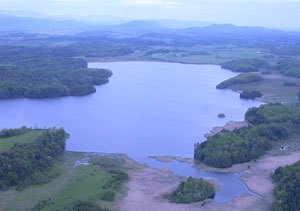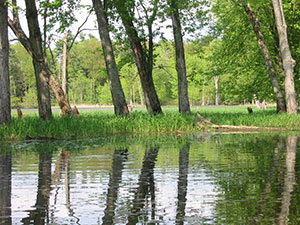A plant community is an assemblage of plant species found within a specific area. The physical boundary between one community and the next is not always clear, but ecologists try to look for natural groupings. For example, a meadow is a plant community consisting of grasses and other flowering plants. A relatively dry meadow in Vermont would be home to species such as daisies, milkweed, goldenrod and fescue. The exact combination of plants you find in any plant community such as a meadow will depend on which species were able to colonize the area and their interaction with the rest of the community.

Upland deciduous forest community
Landscape analysts are interested in the distribution of plant communities for many reasons. Classifying and mapping plant communities tells us how plants are responding to their physical and biological environment, allows us to estimate the biodiversity of an area, and guides land-use planning, forestry and natural resource management. There are several methods used to map plant communities. Some are based on intensive inventories and fieldwork, while others interpolate data based on aerial infrared photography. Some methods provide finer scale mapping than others. Large-scale “land use” maps usually break the landscape into 7 - 15 general categories that include some plant community categories such as crop fields, hard wood forest, and deciduous forest and may help you gain an overview of land use patterns and plant communities in your area.
The dynamics within plant communities are fascinating. However, the spatial distribution and species interactions within a plant community are usually strongly affected by the surrounding environment. Plants respond to soil structure and chemistry, hydrology, and climate. Plants create their own environment as well. Roots change the soil structure and chemistry, and contribute to the weathering process that creates more soil over time. Leaves and large branches create shade and retain moisture in an area and thus create cooler, damper and darker micro-climate that may or may not be favorable for the growth of other species.
Competition between plants and between plants and animals (mainly insects in Vermont) is a major factor that shapes how and where plants are able to thrive. Some plants, such as cinnamon fern have restricted growing conditions and grow under very specific environmental conditions, while others, such as red maple, can tolerate and compete under a wide range of conditions. Some plants compete so successfully
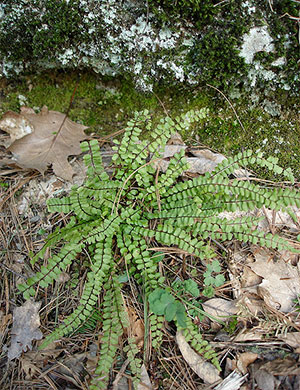
Spleenwort and lichens
As you learn about the plant communities in your area, you will begin to see patterns. Try to identify all of the factors of the physical landscape that shape the patterns you observe. As you learn each new plant in your community, look for signs of how it might interact with other plants or animals. Look for patterns in the distribution of native and non-native species; this might help you further identify the relationship between the cultural history and natural history of your area. Finally, learn to identify the invasive plant species in your area and note their distribution over time.
Shelburne’s Plant Communities
The rich diversity of plant species and communities currently found on the Shelburne landscape is a reflection of many factors, most notably the relatively long growing season, the diversity of soil types, the history of intensive agriculture, and the calcium-rich bedrock. The forests that make up about one-third of the landscape are relatively young, generally having only been released from agriculture within the last century.
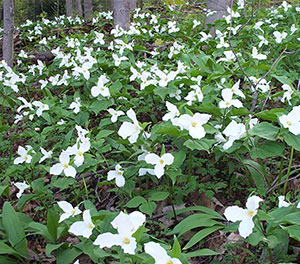
White Trillium in bloom near Shelburne Pond
The upland forests in town tend to be composed of tree species that take advantage of the relatively warm climate (i.e., oaks and hickories), along with those that that compete well when the soils are rich in nutrients (i.e., basswood, ash, butternut, and sugar maple). Floodplain forests dominated by silver maple and green ash are well-represented along the mouth of the LaPlatte River, while the examples of the once extensive clayplain forest are quite rare, with Church Woods at Shelburne Farms being perhaps the only viable remnant.
Springtime in the upland forests of Shelburne is a beautiful and much-anticipated event, when carpets of trillium, wild leeks, bloodroot, along with other spring ephemerals are found blooming in great numbers before the deciduous trees leaf out. The upland forests around Shelburne Pond are particularly renowned in this respect.
